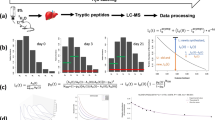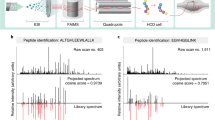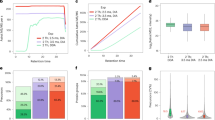Abstract
The adaptation of sequences of chemical reactions to a solid-phase format has been essential to the automation, reproducibility, and efficiency of a number of biotechnological processes including peptide and oligonucleotide synthesis and sequencing1,2,3,4. Here we describe a method for the site-specific, stable isotopic labeling of cysteinyl peptides in complex peptide mixtures through a solid-phase capture and release process, and the concomitant isolation of the labeled peptides. The recovered peptides were analyzed by microcapillary liquid chromatography and tandem mass spectrometry (μLC-MS/MS) to determine their sequences and relative quantities. The method was used to detect galactose-induced changes in protein abundance in the yeast Saccharomyces cerevisiae. A side-by-side comparison with the isotope-coded affinity tag (ICAT) method5 demonstrated that the solid-phase method for stable isotope tagging of peptides is comparatively simpler, more efficient, and more sensitive.
This is a preview of subscription content, access via your institution
Access options
Subscribe to this journal
Receive 12 print issues and online access
$209.00 per year
only $17.42 per issue
Buy this article
- Purchase on Springer Link
- Instant access to full article PDF
Prices may be subject to local taxes which are calculated during checkout



Similar content being viewed by others
References
Merrifield, B. Solid phase synthesis. Science 232, 341–347 (1986).
Caruthers, M.H. et al. Chemical synthesis of deoxyoligonucleotides by the phosphoramidite method. Methods Enzymol. 154, 287–313 (1987).
Hunkapiller, M. et al. Microchemical facility for the analysis and synthesis of genes and proteins. Nature 310, 105–111 (1984).
Edman, P. & Begg, G. A protein sequenator. Eur. J. Biochem. 1, 80–91 (1967).
Gygi, S.P. et al. Quantitative analysis of complex protein mixtures using isotope-coded affinity tags. Nat. Biotechnol. 17, 994–999 (1999).
Holmes, C.P. & Jones, D.G. Reagents for combinatorial organic synthesis: development of a new o-nitrobenzyl photolabile linker for solid phase synthesis. J. Org. Chem. 60, 2318–2319 (1995).
Oda, Y., Huang, K., Cross, F.R., Cowburn, D. & Chait, B.T. Accurate quantitation of protein expression and site-specific phosphorylation. Proc. Natl. Acad. Sci. USA 96, 6591–6596 (1999).
Ideker, T. et al. Integrated genomic and proteomic analyses of a systematically perturbed metabolic network. Science 292, 929–934 (2001).
Han, D., Eng, J., Zhou, H. & Aebersold, R. Quantitative profiling of differentiation-induced membrane associated proteins using isotope-coded affinity tags and mass spectrometry. Nat. Biotechnol. 19, 946–951 (2001).
Washburn, M.P., Wolters, D. & Yates, J.R. 3rd. Large-scale analysis of the yeast proteome by multidimensional protein identification technology. Nat. Biotechnol. 19, 242–247 (2001).
Johnston, M. & Carlson, M. In The molecular and cellular biology of the yeast Saccharomyces (eds. Jones, E.W., Pringle, J.R. & Broach, J.R.) 193–281 (Cold Spring Harbor Press, Cold Spring Harbor, NY; 1992).
Zhou, H., Watts, J.D. & Aebersold, R. A systematic approach to the analysis of protein phosphorylation. Nat. Biotechnol. 19, 375–378 (2001).
Lapatsanis, L., Milias, G., Froussios, K. & Kolovos, M. Synthesis of N-2,2,2-(trichloroethoxycarbonyl)-l-amino acids and N-(9-fluorenylmethoxycarbonyl)-l-amino acids involving succinimidoxy anion as a leaving group in amino acid protection. Synthesis 671–673 (1983).
Ausubel, F.M. et al. (eds.) Current protocols in molecular biology (Wiley, New York; 1992).
Eng, J., McCormack, A.L. & Yates, J.R. 3rd. An approach to correlate tandem mass spectral data of peptides with amino acid sequences in a protein database. J. Am. Soc. Mass Spectrom. 5, 976–989 (1994).
Acknowledgements
This work was supported in part by the US National Cancer Institute grant (CA84698), National Institutes of Health (NIH) Research Resource Center (RR11823), NIH grant (GM 41109) to R.A., and NIH postdoctoral fellowship (GM19884) to J.A.R.
Author information
Authors and Affiliations
Corresponding author
Ethics declarations
Competing interests
The authors declare no competing financial interests.
Supplementary information
Rights and permissions
About this article
Cite this article
Zhou, H., Ranish, J., Watts, J. et al. Quantitative proteome analysis by solid-phase isotope tagging and mass spectrometry. Nat Biotechnol 20, 512–515 (2002). https://doi.org/10.1038/nbt0502-512
Received:
Accepted:
Issue Date:
DOI: https://doi.org/10.1038/nbt0502-512
This article is cited by
-
Proteome-wide detection of S-nitrosylation targets and motifs using bioorthogonal cleavable-linker-based enrichment and switch technique
Nature Communications (2019)
-
Simultaneous quantification of N- and O-glycans using a solid-phase method
Nature Protocols (2017)
-
Sample Multiplexing with Cysteine-Selective Approaches: cysDML and cPILOT
Journal of the American Society for Mass Spectrometry (2015)
-
Using ion purity scores for enhancing quantitative accuracy and precision in complex proteomics samples
Analytical and Bioanalytical Chemistry (2012)



